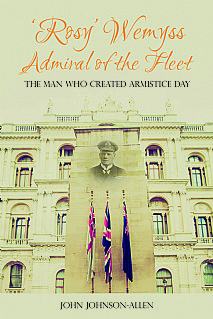
Rosy Wemyss. Admiral of the Fleet. By John Johnson-Allen. Whittles Publishing, Dunbeath, Caithness, Scotland, 2021
Reviewed by Tim Coyle
The Royal Navy of the Victorian and Edwardian periods and up to the end of the First World War is a popular topic of study. RN senior officers of the period have provided a rich field of biographies – Admirals such as the volcanic and brilliant ‘Jackie’ Fisher and his feud with Lord Charles Beresford, the micro-managing Grand Fleet Commander-in-Chief, John Jellicoe and the flamboyant David Beattie. Among those that did not seek celebrity status but worked his way through the ranks to become First Sea Lord (1SL) was Admiral Rosslyn Erskine Wemyss, known to all as ‘Rosy’.
Rosy’s naval career began on 15 July 1887 and ended on 1 November 1919 as an Admiral of the Fleet. In these 43 years the RN passed through a technological revolution, not necessarily associated with a parallel development in strategic, operational and tactical thinking. The RN was the largest navy of the largest empire; its fleets cruised the world and cadets entering the service could expect high adventure in preserving the ‘pax britannica’ in the far-flung regions of the world – coloured red on maps.
Patronage was an asset to a young officer and Rosy, of ancient Scottish nobility was a classmate of Prince George, the Prince of Wales’s son, who would accede to the throne as King George V. They served together in HMS Bacchante on a world tour in 1879 to 1882. Rosy enjoyed postings as a ‘court officer’ in royal yachts and, as a commander, ‘second in command’ of HMS Orphir. Orphir brought Prince George and Princess Mary on a world tour in 1901 which included a visit to Australia for the opening of the first federal parliament in Melbourne.
The book’s author, John Johnson-Allen, traces Rosy’s career through contemporary writings which include the cruises of Bacchante and Orphir, Rosy’s wife Victoria’s memoires, Rosy’s own account of his service in the Dardanelles, his participation in the Armistice negotiations in 1918 and Admiralty files.
As well as his ‘court postings’ Rosy had routine command and flag appointments up to 1915. However, it is the war period that characterised Rosy as an innovative figure in operational planning and diplomacy. He was appointed by First Lord Winston Churchill as naval commander of the port of Mudros, on the island of Lemnos, charged with establishing and operating a vast naval port in support of the Gallipoli landings. His greatest accomplishment was planning and executing the evacuation of the Gallipoli Peninsula with the loss of only one life. Subsequently appointed as Flag Officer East indies and Red Sea, he supported the Arab Revolt against the Turks and worked with Lawrence of Arabia and the Arab leader Emir Feisal.
Rosy succeeded John Jellicoe as 1SL in December 1917 and he represented the Allied navies at the Armistice negotiations at Compiegne in November 1918. Rosy’s journal of this period provides an absorbing narrative of this critical event and is arguably the most fascinating part of the book.
Rosy Wemyss, Admiral of the Fleet is an enjoyable excursion through the RN’s place in the imperial sun until 1914 and Rosy’s unconventional wartime appointments. His contribution to the Armistice places him as a significant figure in the naval history of the 20th century. A well-researched and written tribute to a modest man who achieved high office in the face of political jealousies and served with distinction.



